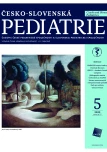New possibilities of echocardiography in the diagnosis of the subclinical form of cardiotoxicity as a consequence of the treatment of children’s oncological diseases
Authors:
Burešová Miroslava
Authors‘ workplace:
Dětské kardiologické oddělení, Pediatrická klinika, Lékařská fakulta Masarykovy univerzity a Fakultní nemocnice Brno
Published in:
Čes-slov Pediat 2022; 77 (5): 297-302.
Category:
Comprehensive Report
doi:
https://doi.org/10.55095/CSPediatrie2022/048
Overview
Cancer in children is the second most common cause of death after injuries. The dramatic progress achieved in the treatment of cancer in children also brings with it the clinical problem of maximizing the benefit of anticancer therapy and at the same time eliminating the late consequences as much as possible. Cardiotoxicity is a very serious side effect of cancer treatment. The method of choice for its detection is echocardiographic examination of the heart. In clinical practice, conventional echocardiographic modalities, such as the measurement of the ejection fraction by the Teichholz method, are still widely used to evaluate left ventricular systolic function. However, we currently have new echocardiographic parameters for early detection of changes in myocardial contractile function. It is a Speckle tracking echocardiography that is able to assess both global and regional myocardial deformity. This method is a non-invasive ultrasound method and detects early stages of left ventricular dysfunction at a time when its ejection fraction is still normal. In particular, the value of the global longitudinal strain should be crucial for predicting the change in ejection fraction. This method shows great potential for time stratification of high-risk patients in the field of cardiooncology.
Keywords:
cardiotoxicity – speckle tracking echocardiography – left ventricular ejection fraction – global longitudinal strain
Sources
1. Štěrba J. Obecná onkologie a podpůrná péče. Úvod do problematiky dětské onkologie. Dostupné z: https://telemedicina.med.muni.cz/pdm/detska - onkologie.
2. Kang Y, Xu X, Cheng L, et al. Two-dimensional speckle tracking echocardiography combined with high-sensitive cardiac troponin T in early detection and prediction of cardiotoxicity during epirubicine-based chemotherapy. Eur J Heart Failure 2014; 16(3): 300–308.
3. Pudil R. Kardiotoxicita protinádorové terapie a současné možnosti diagnostiky. Dostupné z: https://www.labor-aktuell.cz/0319.
4. Bloom MW, Hemo CE, Cardinale D, et al. Cancer Therapy-Related Cardiac Dysfunction and Heart Failure Part 1: Definitions, pathophysiology, risk factors, and imaging. Circ Heart 2016; 9(1): e002661.
5. Zamorano JL, Lancellotti P, Munoz DR, et al. 2016 ESC Position Paper on cancer treatments and cardiovascular toxicity developed under the auspices of the ESC Committee for Practice Guidelines The Task Force for cancer treatments and cardiovascular toxicity of the European Society of Cardiology (ESC). Eur Heart J 2016; 37 : 2768–2801.
6. Pavlíček J, Strnadel J, Gruszka T, et al. Echokardiografické hodnocení srdeční struktury a funkce u dětí s hypertenzí. Cor Vasa 2016; 58(6): e615 – e622.
7. Špinar J, Vítovec J. Co by měl internista vědět o diastolickém srdečním selhání? Intern Med 2005; 7(12): 527–532.
8. Hutyra H, Skála T, Kamínek M, et al. Speckle tracking echokardiografie – nová ultrazvuková metoda hodnocení globální a regionální funkce myokardu. Kardiol Rev Int Med 2008; 10(1): 8–13.
9. Serri K, Reant P, Lafitte M, et al. Global and regional myocardial function quantification by two-dimensional strain: application in hypertrophic cardiomyopathy. J Am Coll Cardiol 2006; 47(6): 1175–1181.
10. Kang Y, Wang W, Zhao H, et al. Assessment of subclinical doxorubicin - -induced cardiotoxicity in a rat model by speckle tracking imaging. Arq Bras Cardiol 2017; 109(2): 132–139.
11. Calle MCA, Sandhu NP, Xia H, et al. Two-dimensional speckle tracking echocardiography predicts early subclinical cardiotoxicity associated with anthracycline-trastuzumab chemotherapy in patients with breast cancer. J List BMC Cancer 2018; 18(1): 1037.
12. Oikonomou EK, Kokkinidis DG, Kampaktsis PN, et al. Assessment of prognostic value of left ventricular global longitudinal strain for early prediction of chemotherapy-induced cardiotoxicity a systematic review and meta - -analysis. JAMA Cardiol 2019; 4(10): 1007–1018.
13. Karlsen S, Dahlslett T, Grenne B, et al. Global longitudinal strain is a more reproducible measure of left ventricular function than ejection fraction regardless of echocardiographic training. Cardiovasc Ultrasound 2019; 17 : 1–12.
14. Araujo-Gutierrez R, Chitturi KR, Xu J, et al. Baseline global longitudinal strain predictive of anthracycline-induced cardiotoxicity. Cardio-Oncology 2021; 7(4): 1–8.
15. Jashari H, Rydberg A, Ibrahimi P, et al. Normal ranges of left ventricular strain in children: a meta-analysis. Cardiovasc Ultrasound 2015; 13(37): 1–16.
16. Piccinelli E, Herberg J, Kang H, et al. Segmental and global longitudinal strain differences between children with paediatric inflammatory multisystem syndrome temporally associated with SARS-CoV-2 pandemic and Kawasaki disease. Eur Heart J 2021; 22(Suppl 1).
17. Sirico D, Costenaro P, Di Chiara C, et al. Left ventricle longitudinal strain alterations in asymptomatic or mildly symptomatic pediatric patients with recent SARS-CoV-2 infection. Eur Heart J 2021; 22(Suppl 1).
18. Poteruche JT, Kutty S, Lindquist SK, et al. Changes in left ventricular longitudinal strain with anthracycline chemotherapy in adolescents precede subsequent decreased left ventricular ejection fraction. J Am Soc Echocardiogr 2012; 25(7): 733–740.
19. A l-Biltagi M, Tolba O, El-Shanshory M, et al. Strain echocardiography in early detection of doxorubicin-induced left ventricular dysfunction in children with acute lymphoblastic leukemia. Int Scholar Res Not 2012; ID 870549. Dostupné z: https://doi.org/10.5402/2012/870549.
Labels
Neonatology Paediatrics General practitioner for children and adolescentsArticle was published in
Czech-Slovak Pediatrics

2022 Issue 5
- What Effect Can Be Expected from Limosilactobacillus reuteri in Mucositis and Peri-Implantitis?
- The Importance of Limosilactobacillus reuteri in Administration to Diabetics with Gingivitis
Most read in this issue
- Hemorrhagic disease of the newborn caused by vitamin K deficiency
- Disseminated intravascular coagulation in children
- Algorithm for recognition a seriously ill child
- Inherited coagulation disorders
